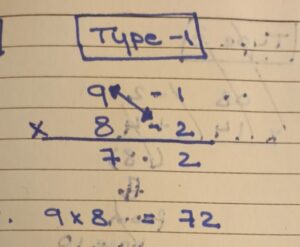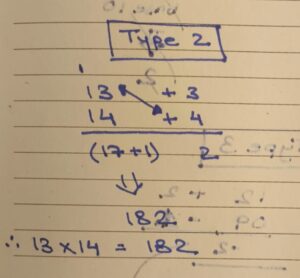Vedic Mathematics is a treasure trove of ancient Indian techniques that simplify complex mathematical operations. Among these, the Nikhilam Sutra, translated as “All from 9 and the Last from 10,” stands out for its elegance and efficiency in handling multiplications.
This blog dives deep into the concept, applications, and nuances of Nikhilam Multiplication, ensuring you grasp this method in its entirety.
What is Nikhilam Multiplication?
At its core, Nikhilam Multiplication revolves around leveraging numbers close to powers of ten (10, 100, 1000, etc.) to simplify calculations. The method involves breaking numbers into deviations from the nearest base and performing a series of straightforward steps to arrive at the result. This approach not only makes calculations faster but also encourages mental math, eliminating the need for extensive written steps.
Advantages of Nikhilam Multiplication
- Speed: By reducing complex calculations to basic additions and multiplications, Nikhilam saves time.
- Flexibility: It works for numbers slightly above or below the base, making it highly versatile.
- Mental Math: With practice, entire operations can be performed in the mind, boosting computational confidence.
- Universal Application: While ideal for near-base numbers, it can also handle far-off numbers with some adaptations.
The Core Principles of Nikhilam Sutra:
1. Identifying the Base
The first step in Nikhilam Multiplication is to identify the nearest power of ten relative to the numbers being multiplied. For instance, if multiplying 97 by 96, the base is 100.
2. Calculating Deviations
Each number is represented as its difference from the identified base:
- For 97, the deviation is −3 (97 – 100 = -3).
- For 96, the deviation is −4 (96 – 100 = -4).
3. Multiplying Deviations
The product of these deviations forms one part of the answer. For the example above:
(−3)×(−4)=12
4. Adding Crosswise
The other part of the answer comes from adding one number to the deviation of the other. Alternatively, subtracting the deviation of one number from the other also works:
97−4=93 or 96−3=93
5. Combining the Results
The final answer is obtained by combining the two parts, with the base dictating the placement of digits:
9312(93 as the main number and 12 as the right-hand part)
Video Tutorial for Nikhilam Multiplication Method
If you are more of a visual learner than a geek, it is recommended that you try to understand this concept with the help of a video tutorial we use to help our students at Vedic Math School understand.
Types of Nikhiilam Multiplication Method:
The 3 subtypes in the Nikhilam Multiplication Method
- The number is below the base value
- The number is above the base value
- The number is above and below the base value
Let’s understand these three subtypes better with some examples.
Subtype 1: The number is below the base value
Example 1: What is 9 x 8?
Solution: Since we can see that the numbers are below the base value.
Base: 10
Deviations: −1 and −2
Step 1: Multiply deviations: (−1)×(−2)=2
Step 2: Add crosswise: 9 + (-2) = 7
Final Answer: 72
Subtype 2: The number is above the base value
Example 2: What is 13 x 14?
- Solution: Since we can see that the numbers are above the base value.
- Base: 10
- Deviations: +3 and +4
- Step 1: Multiply deviations: (+3)×(+4)=12, [1 is carry]
Step 2: Add crosswise: 14 + 3 = 17 + 1 [1 carry from the last step]
Final Answer: 182
Subtype 3: The number is above and below the base value
Multiply 104 and 97:
Here you can see that one number is above and the other is below the base value:
- Base: 100
- Deviations: +4 and −3
- Step 1: Multiply deviations: (+4)×(−3)=−12
- Step 2: Add crosswise: 104−3=101
- Adjust for the negative: We need to put 00 (since the base is 100) after Step 2 and Subtract 12 from there,
- So it will be like: 10100- 12 = 10088
Practical Examples of Nikhilam Multiplication
Example 1: Multiplying Numbers Below the Base
Let’s multiply 98 and 97 using Nikhilam:
- Base: 100
- Deviations: −2 and −3
- Step 1: Multiply deviations: (−2)×(−3)=6
- Step 2: Add crosswise: 98−3=95
- Final Answer: 9506
Example 2: Multiplying Numbers Above the Base
Multiply 103 and 104:
- Base: 100
- Deviations: +3 and +4
- Step 1: Multiply deviations: (+3)×(+4)=12
- Step 2: Add crosswise: 103+4=107
- Final Answer: 10712
Example 3: One Number Above and One Below
Multiply 102 and 97:
- Base: 100
- Deviations: +2 and −3
- Step 1: Multiply deviations: (+2)×(−3)=−6
- Step 2: Add crosswise: 102−3=99
- Adjust for the negative: Subtract 6 from 00 (since the base is 100), So it will be like: 9900- 6 = 9894
To get more clarity on this step, I recommend you to watch the attached video with this blog.
Handling Larger Bases and Numbers
For larger bases, such as 1000, the steps remain the same, but the placement of digits changes. The right-hand part of the result must have as many digits as there are zeros in the base.
Example 4: Numbers Near 1000
Multiply 995 and 990:
- Base: 1000
- Deviations: −5 and −10
- Step 1: Multiply deviations: (−5)×(−10)=50
- Step 2: Add crosswise: 995−10=985
- Final Answer: 985050
Using Nikhilam for Decimal Multiplications
Nikhilam isn’t limited to integers; it seamlessly extends to decimals. The key is to align decimal places with the base.
Example 5: Multiplying Decimals
Multiply 9.7 by 9.6:
- Base: 10
- Deviations: −0.3 and −0.4
- Step 1: Multiply deviations: (−0.3)×(−0.4)=0.12
- Step 2: Add crosswise: 9.7−0.4=9.3
- Final Answer: 9.312
Common Mistakes and Tips for Mastery
- Choosing the Base Wisely: Always select the nearest power of ten to minimize deviations.
- Handling Negative Results: For products with negative deviations, adjust the result appropriately by borrowing from the base.
- Practising Crosswise Addition: Accuracy in this step ensures the final answer is correct.
- Using Zeros for Padding: When deviations result in fewer digits, pad with zeros to match the base.
Practice Questions
Easy Level
- Multiply 98 × 97 using the base of 100.
- Multiply 103 × 104 using the base of 100.
- Multiply 99 × 99 using the base of 100.
- Multiply 95 × 96 using the base of 100.
- Multiply 102 × 98 using the base of 100.
Intermediate Level
- Multiply 994 × 992 using the base of 1000.
- Multiply 1007 × 1008 using the base of 1000.
- Multiply 101 × 97 using the base of 100.
- Multiply 89 × 96 using the base of 100.
- Multiply 9.7 × 9.6 using the base of 10.
Hard Level
- Multiply 986 × 995 using the base of 1000.
- Multiply 10,002 × 9995 using the base of 10,000.
- Multiply 1025 × 975 using the base of 1000.
- Multiply 887 × 998 using the base of 1000.
- Multiply 9.92 × 10.08 using the base of 10.
Why Learn Nikhilam Multiplication?
In a world where efficiency is key, mastering Nikhilam can be a game-changer. Whether you’re a student facing competitive exams or a professional looking to sharpen mental math skills, this technique is invaluable. Its simplicity, combined with its profound impact on speed and accuracy, makes it a must-learn for anyone passionate about mathematics.
Final Thoughts
The Nikhilam Sutra exemplifies the brilliance of Vedic Mathematics, turning seemingly complex multiplications into straightforward tasks. By practising this method, you’ll not only improve your calculation speed but also develop a deeper appreciation for the elegance of mathematical thought. So why not leap and add this ancient technique to your arsenal?
Are you ready to transform your approach to multiplication? Dive into the world of Nikhilam and experience the magic firsthand!




